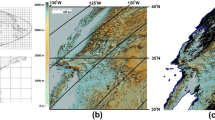Abstract
A new method for elevation and latitude decorrelation stretch of multi-temporal land surface temperature (LST) in the East Africa Rift System (EARS) from MODIS 2008 monthly average night imagery and Globe digital elevation model (DEM) is presented. Multiple linear regression analysis of principal components images (PCAs) quantifies the variance explained by elevation and latitude. Selective variance reduction (SVR) reconstructs the multi-temporal LST imagery from the residual images and selected PCAs by taking into account the portion of variance not related to elevation and latitude. Clustering of the reconstructed imagery identifies two major thermal anomalies a) in the Afar Triangle, and b) a new one in between the Ethiopia and Kenya. These regions present LST values higher than the elevation and latitude predicted ones through out the year. It is assumed that the new thermal anomaly corresponds to a triple junction formed in between the Ethiopian Rift and the Eastern and the Western branches of the EARS, in an area where active volcanoes and mantle plume activity concentrate. SVR is expected to assist tectonic and volcanic zones characterization on the basis of their thermal response.











Similar content being viewed by others
References
Chorowicz J (2005) The East African rift system. J Afr Earth Sci 43:379–410
Corti G (2009) Continental rift evolution: from rift initiation to incipient break-up in the Main Ethiopian Rift, East Africa. Earth Sci Rev 96:1–53
Dewey J, Burke K (1974) Hot spots and continental breakup. Geology 2:57–60
Dugda M, Nyblade A, Julia J (2007) Thin lithosphere beneath the Ethiopian Plateau revealed by a joint inversion of Rayleigh Wave Group velocities and receiver functions. J Geophys Res 112. doi:10.1029/2006JB004918
Eastman J, Fulk M (1993) Long sequence time series evaluation using standardized principal components. Photogramm Eng Remote Sens 59:1307–1312
Girdler R (1991) The Afro-Arabian rift system-an overview. Tectonophysics 197:139–153
GLOBE (1999) The global land one-kilometer base elevation digital elevation model, National Oceanic and Atmospheric Administration, National Geophysical Data Center, Boulder, Colorado. Retrieved April 25 2011, Available at: http://www.ngdc.noaa.gov/mgg/topo/globe.html
Landam S, Everitt B (2004) A handbook for statistical analyses using SPSS. Chapman & Hall/CRC Press, New York
Mather P (2004) Computer processing of remotely-sensed images. Wiley, New York
Miliaresis G (2009) Regional thermal and terrain modeling of the Afar depression from multi-temporal night LST data. Int J Remote Sens 30:2429–2446
Miliaresis G, Seymour K (2011) Mapping the spatial & temporal SST variations in Red Sea, revealing a probable regional geothermal anomaly from Pathfinder V5 data. Int J Remote Sens 32:1825–1842
MYD11C3 Ver.005 (2008) LST & emissivity monthly L3 global 0.05 Deg CMG, Land Processes Distributed Active Archive Center, U.S.G.S. Retrieved April 25 2011, Available at: https://lpdaac.usgs.gov/lpdaac/products/modis_products_table/land_surface_temperature_emissivity/monthly_l3_global_0_05deg_cmg/myd11c3
Siebert L, Simkin T, Kimberly P (2010) Volcanoes of the world, 3 rd edition: Smithsonian Institution. University of California Press
Siljestrom P, Moreno A, Vikgren G, Caceres L (1997) The application of selective principal components analysis to a Thematic Mapper image for the recognition of geomorphologic features configuration. Int J Remote Sens 18:3843–3852
SRTM4 (2011) Resampled version 4 SRTM data to 250 m resolutions for the entire globe, CGIAR Consortium for Spatial Information. Retrieved April 25 2011, Available at: http://srtm.csi.cgiar.org/
Wan Z, Zhang Y, Zhang Q, Li Z (2004) Quality assessment and validation of the MODIS land surface temperature. Int J Remote Sens 25:261–274
Wang K, Liang S (2009) Evaluation of ASTER and MODIS land surface temperature and emissivity products using long-term surface longwave radiation observations at SURFRAD sites. Remote Sens Environ 113:1556–1565
Acknowledgements
The author is grateful for and this paper was benefited significantly from the comments and suggestions of an anonymous reviewer and Prof. Guido Ventura (Instituto Nazionale di Geofisica e Vulcanologia, Italy).
Author information
Authors and Affiliations
Corresponding author
Additional information
Communicated by H. A. Babaie
Rights and permissions
About this article
Cite this article
Miliaresis, G. Selective variance reduction of multi-temporal LST imagery in the East Africa Rift System. Earth Sci Inform 5, 1–12 (2012). https://doi.org/10.1007/s12145-011-0091-6
Received:
Accepted:
Published:
Issue Date:
DOI: https://doi.org/10.1007/s12145-011-0091-6




